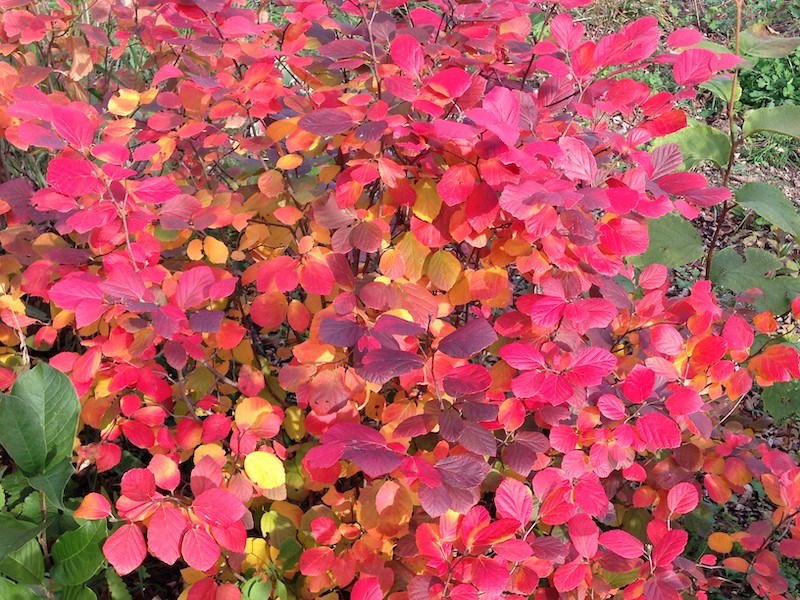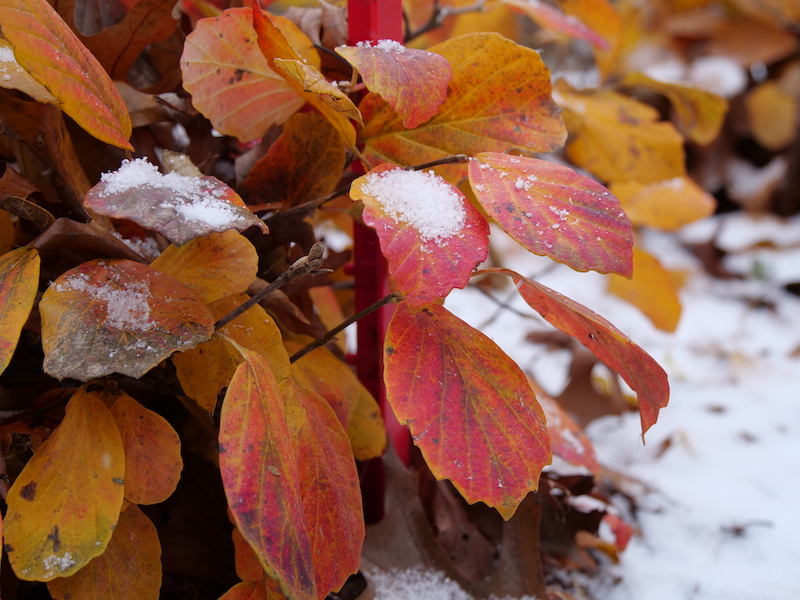Growing Fothergilla
With its unique brush-shaped ivory florets consisting of only stamens and no petals, Fothergilla serves its first course of seasonal interest in spring. Next plate? After the flowers have begun to bloom, emerald leaves then unfurl and continue throughout the summer. For the third course, Fothergilla’s delicately textured foliage morphs into an autumnal mélange of mauve, red-orange, and chartreuse. And, finally, for dessert, uniquely shaped, meandering branches appear during winter. No doubt, this deciduous shrub is a conversation piece four out of four seasons.

While adaptable to many conditions, this versatile, Southeastern native thrives in full sun. Fothergilla major, or large witch alder, includes the taller varieties, while Fothergilla gardenii, or dwarf witch alder, consists of the more compact versions. The maximum height of this shrub is typically between 3-10 feet. Cold hardy in zones 4 to 8 and disease and deer resistant, this shrub is easy to care for and low maintenance. Its adaptability and slow growth make Fothergilla a wise choice for any busy gardener searching for a new ornamental shrub offering rare, vibrant interest year-round.
Planting Fothergilla
During spring or autumn, choose a planting spot that gets full sun. Fothergilla does best if provided 6 to 8 hours of direct light per day. Dig a hole close to the same depth as the root ball’s height and two times as wide. Plant Fothergilla in moist, loamy, acidic soil that drains well. Amend soil with compost if the soil is compact or infertile. The pH should ideally be in the range of 5.0 to 6.0. Add a thick layer of mulch to retain moisture around the root zone. Great companion plants include azaleas, chokeberry, Japanese pieris, mountain laurels, phlox, and rhododendron.

Watering Fothergilla
Until established, water Fothergilla twice per week. Having average water requirements, Fothergilla needs only about one inch of water per week. Fothergilla is slightly temperamental where soil moisture is concerned. On the one hand, it does not thrive during periods of drought, so ensure that it receives adequate amounts of water during this time. On the other hand, this ornamental dislikes boggy conditions, so ensure its soil is dry before watering. Water it deeply when the top one inch of soil is dry. Applying a 1-to-2-inch mulch layer will help prevent unnecessary water loss due to dehydration. Adding mulch is especially important if Fothergilla is located in full sun.
Fertilizing Fothergilla
To support the rounded growth of this slow-growing shrub, apply a fertilizer designed for acid-loving plants once a month during the spring. Water the soil well to protect the roots from fertilizer burn and aid in nutrient absorption.
Pruning Fothergilla
Due to its natural, free-form shape, Fothergilla does not require heavy pruning. Its unique zig-zagging branches provide interest despite being leafless during winter. During late winter, however, remove dead, diseased, damaged and crossed stems. This light pruning will decrease chances of disease and encourage future growth by improving aeration. Then, after the last blooms have fallen in late spring, remove any suckers.
Caring For Fothergilla in Pots
Choose a container at least 2 to 4 inches larger than Fothergilla’s root ball and fill it with potting soil formulated for acid-loving plants. Add a one-inch layer of mulch at the top of the container. Plant Fothergilla alone or as a thriller in a thriller-spiller-filler combination. This shrub pairs particularly well with heather and coneflower to produce a mixed flower combination with varied color, height, and texture. Whether planted alone or in a mixed arrangement, Fothergilla will add year-round interest to patios, porches, and decks.

Winter Care for Fothergilla
Depending on the hardiness zone, Fothergilla is typically a deciduous perennial. In climates with harsh winters, you can loosely bind the branches with twine and cover them with burlap to overwinter. Using a frost blanket will help protect Fothergilla’s foliage and roots during the cold months of winter.
Common Fothergilla Care Questions
What Is The Growth Rate Of Fothergilla?
Fothergilla is slow growing but long-lived- may reach up to 60 years.
When Should Fothergilla Be Pruned?
Only prune in late spring after it flowers.
How Much Sun Does Fothergilla Need?
Fothergilla thrive in sun at all times, but they can also thrive in part shade. Flowers occur in Full sun.
Does Fothergilla Bloom on Old Wood?
It blooms in spring on old growth/ old wood or the previous season's growth.
Can Fothergilla Be Transplanted?
Yes, Transplanting is best in early spring before growth and second best in the fall.
Have a question about Fothergilla? Fill out the form below and we will try and get back to your question as soon as possible. We may even feature your question in this article to help other gardeners!
 |
Author Suellen Barnes - Published 2-26-2023 |
